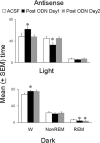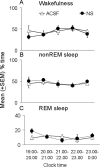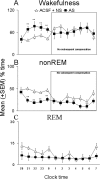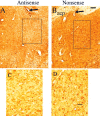A1 receptor and adenosinergic homeostatic regulation of sleep-wakefulness: effects of antisense to the A1 receptor in the cholinergic basal forebrain
- PMID: 12764116
- PMCID: PMC2002519
- DOI: 10.1523/JNEUROSCI.23-10-04278.2003
A1 receptor and adenosinergic homeostatic regulation of sleep-wakefulness: effects of antisense to the A1 receptor in the cholinergic basal forebrain
Abstract
We hypothesized that adenosine, acting via the A1 receptor, is a key factor in the homeostatic control of sleep. The increase in extracellular levels of adenosine during prolonged wakefulness is thought to facilitate the transition to sleep by reducing the discharge activity of wakefulness-promoting neurons in the basal forebrain. Adenosine A1 receptor control of the homeostatic regulation of sleep was tested by microdialysis perfusion of antisense oligonucleotides against the mRNA of the A1 receptor in the magnocellular cholinergic region of the basal forebrain of freely behaving rats. After microdialysis perfusion of A1 receptor antisense in the basal forebrain, spontaneous levels of sleep-wakefulness showed a significant reduction in non-rapid eye movement (REM) sleep with an increase in wakefulness. After 6 hr of sleep deprivation, the antisense-treated animals spent a significantly reduced amount of time in non-REM sleep, with postdeprivation recovery sleep hours 2-5 showing a reduction of approximately 50-60%. There was an even greater postdeprivation reduction in delta power (60-75%) and a concomitant increase in wakefulness. All behavioral state changes returned to control (baseline) values after the cessation of antisense administration. Control experiments with microdialysis perfusion of nonsense (randomized antisense) oligonucleotides and with artificial CSF showed no effect during postdeprivation recovery sleep or spontaneously occurring behavioral states. Antisense to the A1 receptor suppressed A1 receptor immunoreactivity but did not show any neurotoxicity as visualized by Fluoro-Jade staining. These data support our hypothesis that adenosine, acting via the A1 receptor, in the basal forebrain is a key component in the homeostatic regulation of sleep.
Figures







Similar articles
-
Adenosinergic modulation of basal forebrain and preoptic/anterior hypothalamic neuronal activity in the control of behavioral state.Behav Brain Res. 2000 Nov;115(2):183-204. doi: 10.1016/s0166-4328(00)00258-8. Behav Brain Res. 2000. PMID: 11000420
-
Adenosinergic inhibition of basal forebrain wakefulness-active neurons: a simultaneous unit recording and microdialysis study in freely behaving cats.Neuroscience. 2003;122(4):1107-13. doi: 10.1016/j.neuroscience.2003.08.006. Neuroscience. 2003. PMID: 14643776
-
Microdialysis perfusion of orexin-A in the basal forebrain increases wakefulness in freely behaving rats.Arch Ital Biol. 2001 Apr;139(3):313-28. Arch Ital Biol. 2001. PMID: 11330208
-
Adenosine and sleep-wake regulation.Prog Neurobiol. 2004 Aug;73(6):379-96. doi: 10.1016/j.pneurobio.2004.06.004. Prog Neurobiol. 2004. PMID: 15313333 Review.
-
[Adenosine in sleep regulation].Rev Neurol (Paris). 2001 Nov;157(11 Pt 2):S7-11. Rev Neurol (Paris). 2001. PMID: 11924043 Review. French.
Cited by
-
Sites of action of sleep and wake drugs: insights from model organisms.Curr Opin Neurobiol. 2013 Oct;23(5):831-40. doi: 10.1016/j.conb.2013.04.010. Epub 2013 May 23. Curr Opin Neurobiol. 2013. PMID: 23706898 Free PMC article. Review.
-
Effects of ibotenate and 192IgG-saporin lesions of the nucleus basalis magnocellularis/substantia innominata on spontaneous sleep and wake states and on recovery sleep after sleep deprivation in rats.J Neurosci. 2008 Jan 9;28(2):491-504. doi: 10.1523/JNEUROSCI.1585-07.2008. J Neurosci. 2008. PMID: 18184792 Free PMC article.
-
Diaphragm long-term facilitation following acute intermittent hypoxia during wakefulness and sleep.J Appl Physiol (1985). 2011 May;110(5):1299-310. doi: 10.1152/japplphysiol.00055.2011. Epub 2011 Mar 3. J Appl Physiol (1985). 2011. PMID: 21372099 Free PMC article.
-
Impaired glucose tolerance in the absence of adenosine A1 receptor signaling.Diabetes. 2011 Oct;60(10):2578-87. doi: 10.2337/db11-0058. Epub 2011 Aug 10. Diabetes. 2011. PMID: 21831968 Free PMC article.
-
Is Adenosine Action Common Ground for NREM Sleep, Torpor, and Other Hypometabolic States?Physiology (Bethesda). 2018 May 1;33(3):182-196. doi: 10.1152/physiol.00007.2018. Physiology (Bethesda). 2018. PMID: 29616880 Free PMC article. Review.
References
-
- Basheer R, Rainnie DG, Porkka-Heiskanen T, Ramesh V, McCarley RW ( 2001a) Adenosine, prolonged wakefulness, and A1-activated NF-kB DNA binding in the basal forebrain of the rat. Neuroscience 104: 731–739. - PubMed
-
- Basheer R, Halldner L, Alanko L, McCarley RW, Fredholm BB, Porkka-Heiskanen T ( 2001b) Opposite changes in adenosine A1 and A2A receptor mRNA in the rat following sleep deprivation. NeuroReport 12: 1577–1580. - PubMed
-
- Biggs TA, Myers RD ( 1997) Adenosine A1 receptor antisense infused in striatum of rats: actions on alcohol-induced locomotor impairment, blood alcohol, and body temperature. Alcohol 14: 617–621. - PubMed
Publication types
MeSH terms
Substances
Grants and funding
LinkOut - more resources
Full Text Sources
Other Literature Sources
